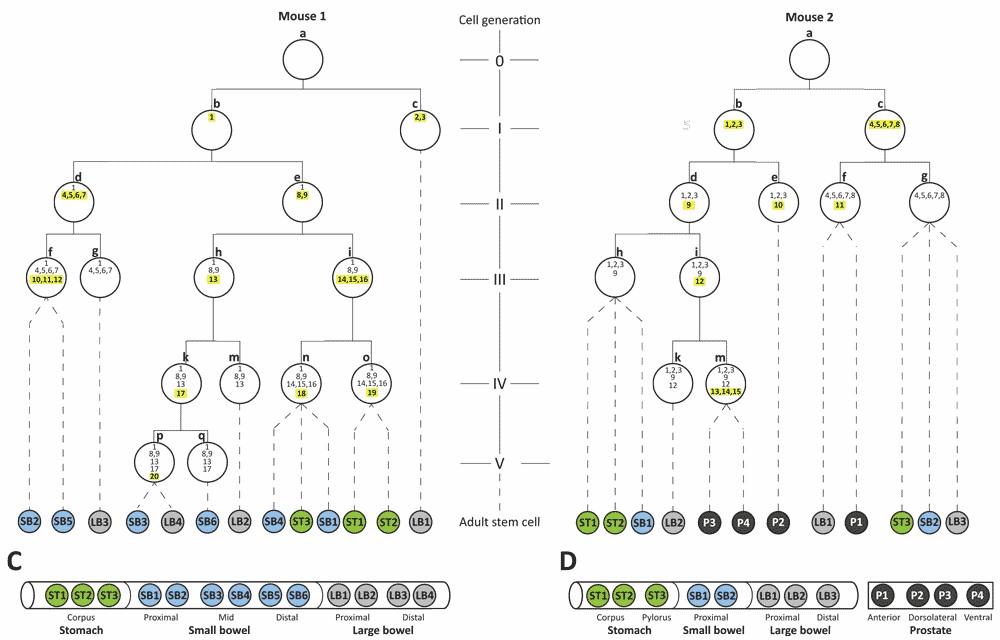Reconstructing the life history of a single cell

During the life of an individual, all cells in the body develop mutations, known as somatic mutations, which are not inherited from parents or passed on to offspring. These somatic mutations carry a coded record of the lifetime experiences of each cell.
By looking at the numbers and types of mutations in a cell’s DNA, researchers were able to assess whether the cell had divided a few times or many times and detect the imprints, known as signatures, of the processes of DNA damage and repair that the cells had been exposed to during the life of the individual. Furthermore, comparing each cell’s mutations with those of other cells in the body enabled scientists to map out a detailed tree of development from the fertilised egg.
“With this novel approach, we can peer back into an organism’s development. If we can better understand how normal, healthy cells mutate as they divide over a person’s lifetime, we will gain a fundamental insight into what can be considered normal and how this differs from what we see in cancer cells.”
Dr Sam Behjati First author from the Wellcome Trust Sanger Institute
The team looked at mouse cells from the stomach, small bowel, large bowel and prostate. The single cells were grown to produce enough DNA to be sequenced accurately. Eventually, single-cell sequencing technology will develop so that this type of experiment can be conducted using just one cell. However, the tiny amounts of DNA in single cells mean that mutation data are not currently precise enough to reconstruct accurate lineages.
The researchers recorded differences in the numbers of mutations in cells from the different tissues studied, likely attributable to differences in rates of cell division. Moreover, different patterns of mutation were found in cells from different tissues, suggesting that they have been exposed to different processes of DNA damage and repair, reflecting different lifetime experiences.
This experiment used healthy mice. If mutation rates are similar in human cells, these techniques could be used to provide an insight into the life histories of normal human cells.
“The adult human body is composed of 100 million million cells, all of which have originated from a single fertilised egg. Much more extensive application of this approach will allow us to provide a clear picture of how adult cells have developed from the fertilised egg. Furthermore, by looking at the numbers and types of mutation in each cell we will be able to obtain a diary, writ in DNA, of what each healthy cell has experienced during its lifetime, and then explore how this changes in the range of human diseases.”
Professor Mike Stratton Senior author and Director of the Sanger Institute
More information
Funding
A full list of funding can be found on the paper.
Participating Centres
Please see the paper for a full list of participating centres.
Publications:
Selected websites
The Hubrecht Institute for Developmental Biology and Stem Cell Research
The Hubrecht Institute for Developmental Biology and Stem Cell Research focuses on developmental biology and stem cells at the organismal, cellular, genetic, genomic and proteomic level. Basic insight into development and into stem cells will provide insight into (human) disease, such as cancer. The Hubrecht Institute is affiliated with the University Medical Center Utrecht and has close connections with the Utrecht University.
The Wellcome Trust Sanger Institute
The Wellcome Trust Sanger Institute is one of the world’s leading genome centres. Through its ability to conduct research at scale, it is able to engage in bold and long-term exploratory projects that are designed to influence and empower medical science globally. Institute research findings, generated through its own research programmes and through its leading role in international consortia, are being used to develop new diagnostics and treatments for human disease.
The Wellcome Trust
The Wellcome Trust is a global charitable foundation dedicated to achieving extraordinary improvements in human and animal health. We support the brightest minds in biomedical research and the medical humanities. Our breadth of support includes public engagement, education and the application of research to improve health. We are independent of both political and commercial interests.


